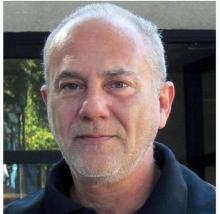
Carlos Trilnick (1957–2020)
Saturday, June 27, Carlos Trilnick left us.
It is difficult for me to summarize in a handful of roles what Carlos represented, even more so being one of the tens of thousands of people he educated as a teacher, but having stayed in classrooms and projects with him these last 15 years of work and friendship, I allow myself to summarize his life without the formality of a newspaper clipping.
Something that always amazed me about Carlos was his ability in a class or in a presentation, to be intellectually the most radical of the group, Carlos's harangues in favour of the subjective gaze, the nonlinearity in the construction of stories, whether audiovisual or historiographic, and the demystification of the deities of institutional modes of representation—which he used to illustrate with the metaphor of churches becoming movie theatres—ignited rebellion and enthusiasm in the classroom, opening the heart of each student, giving us the opportunity to go out and describe the world with images and sounds the way we wanted. Obviously, this way of being made things difficult for him more than once. Carlos was disturbing for many, not only because of his intelligence but also because of his stubbornness and meticulousness, the man did not keep quiet.
I know from his own stories of his career in the '80s and '90s when he returned from exile, founding things everywhere, he organized in the ICI of Buenos Aires, the first five editions of the exhibition "Buenos Aires Video" (1989–1993), culminating with the edition in 1993 of the catalogue "Buenos Aires Video V" that reviews artistic activity with technological means in Argentina since 1929. He was also artistic director of the Festival of Video and Electronic Arts in Buenos Aires.
Carlos embodied what video represents as media of expression, self-management, experimentation, and even defeat, as he told me several times.
During the '90s, he established himself as a benchmark in video and electronic arts, thanks to his hyperactivity and creative ability, and founded, together with Luis Campos, and as part of the Image and Sound Design program at FADU – UBA (University of Buenos Aires), the area in which they educated—literally—more than ten thousand people. Later, he was also the director of the same degree of Image and Sound Design between 2014 and 2018, promoting and achieving the so laborious and necessary updating of the study plan.
In 2008 he founded Proyecto IDIS (proyectoidis.org), a database that articulates alternative historiography of the design of images and sounds, focusing on the peripheries of creation and the analog-digital transition. The site currently has more than sixty thousand monthly visits from all over Latin America.
Carlos was a creator, juror, teacher, curator, researcher, videographer, thinker, artist, photographer and surely several other things, all with the same intensity, the highest possible. Not for all that, he ceased to be, with a sweetness unknown in other areas, father and husband, and in what concerns me, a dear friend and mentor, whose greatness in life and work we take into account today, experiencing with great sadness the departure of someone we always feel so close.
